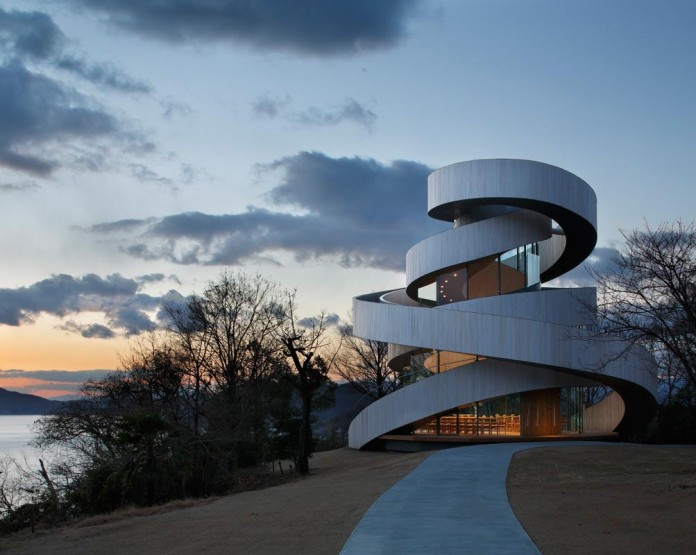Ribbon Chapel by NAP Architects
Architects: NAP Architects
Location: Hiroshima, Hiroshima Prefecture, Japan
Year: 2013
Area: 861 sqft / 80 sqm
Photo courtesy: Koji Fujii / Nacasa & Partners Inc
Description:
Two Spirals Become One
This wedding church remains in a patio nursery of a resort lodging, “Bella Vista Sakaigahama,” in Onomichi, Hiroshima. The site is halfway on a slope getting a charge out of an all encompassing perspective of the Inland Sea of Japan. By lacing two winding stairways, we understood an unattached building of phenomenal sythesis and structurally exemplified the demonstration of marriage in an unadulterated structure. A solitary winding stairway would be temperamental in a flat heading and is inclined to vibration in a vertical course, henceforth, extremely flimsy.
By joining two winding stairways so one backings the other, we created a detached structure. Pretty much as two lives experience wanders aimlessly before uniting as one, the two spirals flawlessly associate at their 15.4m summit to shape a solitary strip. At the center of their development is a house of prayer where the general population who have upheld the spouse and man of the hour are holding up. The church path looks toward a current image tree. The sacrificial stone stands before the tree, and 80 seats are situated for perspectives to the sea through the trees.
Commonly, a building is made out of unmistakable components: rooftop, divider, and floor. Here, be that as it may, the weaving stairways execute as rooftops, overhang, dividers, and floors to deliver the building’s spaces. The stairways extend in expansiveness in light of area and capacity, for example, at the summit where the couple meets, in headings having fine perspectives, and in spots where the overhang must be profound to shield the inside from the sun.
The building’s outside is done in upright wood boards, painted white in order to extend in excellence over the long haul, and titanium zinc compound, a material impervious to harm from the ocean breeze and sufficiently malleable to be connected to shape. Utilizing the zinc combination on the adapting, dividers, roof, and window bands empowered a basic outline bound together by method for a solitary material.
The building kind of wedding houses of prayer has dependably taken after a course setup. The lady strolls down the walkway with her dad, and after the service, the same passageway turns into a course of flight for the spouse and husband to be. During the time spent strolling this way, every stride stirs recollections and feelings. Luckily, in this sanctuary, the function likewise takes structure as the spouse and husband to be climb separate stairways to meet at the top, request paradise’s authorization to join as one, and announce their marriage. The two, who have lived separate lives, then stroll down the stairway together.
The straightforward building is made just out of ways, along which views of sea, mountains, sky, and far off islands progressively show up and vanish. In spite of the fact that it is just a little building, we attempted to oblige the feelings of the lady and groom and the contemplations of the celebrants by extending the walkway to an aggregate length of 160m and growing the scope of encounters. (Hiroshi Nakamura)
Commonly Supporting Spirals
By interfacing the four focuses in four headings where the two stairways approach firmly together with coupling components, we created a three-dimensional loop impact for limiting the outward swell and a three-dimensional prop impact for opposing level powers – in this manner making the two spirals commonly supporting and self-standing. The 100mm-measurement middle posts of strong steel which just backing the vertical burden, woefully bolster the internal winding. The external winding is coupled to the internal winding as a shade. Keeping in mind the end goal to help the volume of steel edge in the upper part, we utilized a pendulum-sort base segregation gadget for lightweight structures. At three areas in the external winding staircase where we felt the best worry about footfall-prompted vibration, we set up a shade sort tuned mass damper (TMD) to control the vibration.
It was predicted that, when the falsework was evacuated, the building would experience most extreme 30mm rotational sedimentation under its own weight, which may bring about the middle of the road presents on incline. We in this way built up a basic model which applies a same measure of opposite torque as the foreordained characteristic rotational power which causes the sedimentation. Subsequently, the posts, intentionally inclined for development, got to be vertical after the finishing of development and stayed inside of a 2/1,000 room for give and take between floors. This sensitive yet intense auxiliary outline was made by Ikuhide Shibata of Arup. (Hiroshi Nakamura)
Information Sheet Sash Detail
The glass windows all vary in stature, thickness and shape. To empower the glass sheet to move unreservedly under the three-dimensional torque of the building amid a tremor or solid winds, the sheet is held with speck point coating (DPG) arms connected to the internal side of the ascent of the titanium zinc amalgam adapting.
Thank you for reading this article!





























